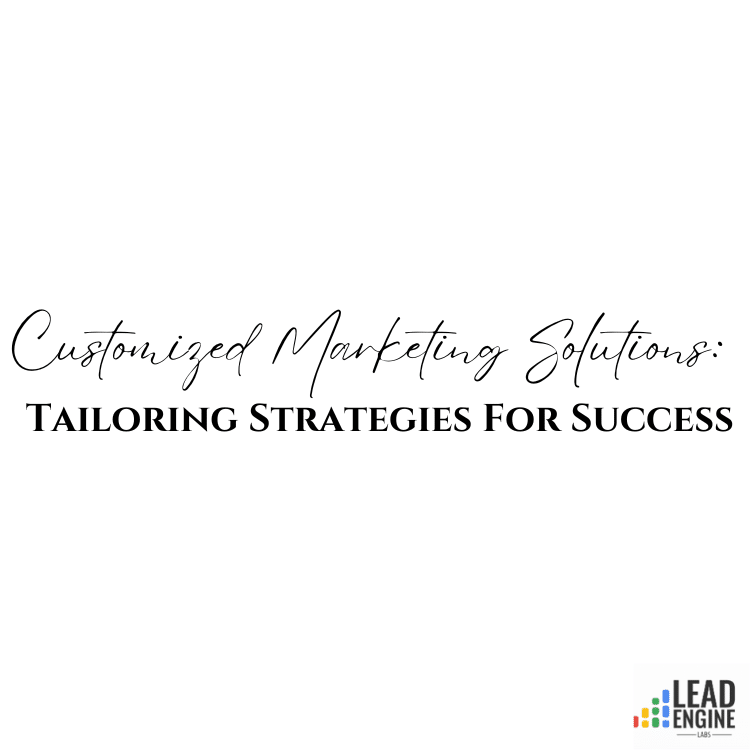Are you tired of using generic marketing strategies that do not resonate with your audience? Do you want to take your business to the next level and stand out in a crowded marketplace? If so, customized marketing solutions are the key to success.
Tailoring your marketing strategies to meet the unique needs and preferences of your target audience can help you connect with them on a deeper level, build brand loyalty, and drive sales. By leveraging personalized messages, digital tools, and collaboration with experts in the field, you can create a powerful marketing strategy that sets your business apart from the competition.
In this article, we will explore how customized marketing solutions can help you achieve success in today’s ever-changing market landscape.
Key Takeaways
- Customized marketing solutions are essential for success in today’s market landscape.
- Personalization is key to driving conversions and building customer loyalty.
- Digital marketing tools like social media, email campaigns, and website optimization can boost marketing efforts.
- Measuring success through KPIs, and metrics, and adapting to changing market trends is crucial for sustained growth and profitability.
Understanding Your Business Needs
You need to figure out exactly what your business needs are so we can create a customized marketing solution that fits like a glove. Analyzing competition and identifying your target audience is crucial in developing a marketing plan that will stand out from the rest.
Knowing who your competitors are and what they offer will help us craft unique selling points for your business, setting you apart from the rest. Identifying your target audience is equally important. Understanding their needs, wants, and preferences will help us tailor our marketing efforts to cater specifically to them.
Setting Clear Goals and Objectives
By establishing clear goals and objectives, businesses can create more effective customized marketing solutions. Goal-setting techniques play a crucial role in creating a marketing strategy that aligns with your business’s overall objectives. Without clearly defined goals, it’s challenging to measure the success of your marketing campaigns accurately.
To set clear goals and objectives, you need to identify what you want to achieve through your marketing efforts. It could be anything from increasing brand awareness to generating leads or driving sales. Once you’ve identified your goals, break them down into measurable metrics that help track progress over time.
Developing a Strong Brand Identity
Creating a strong brand identity is like building the foundation of a house – it requires careful planning and attention to detail. Your brand identity is the way your business presents itself to the world. It’s what sets you apart from your competitors and makes you recognizable to your target audience.
To create a strong brand identity, you need to start by defining your brand consistency and voice. Brand consistency means that every touchpoint with your customers should look and feel consistent across all platforms. From your website design to social media posts, everything needs to have a consistent look and tone that reflects your brand values.
Choosing the Right Marketing Channels
Choosing the right marketing channels is crucial in ensuring that your message reaches the people who are most likely to be interested in what you offer. To help you make informed decisions, it’s important to evaluate the effectiveness of different channels.
One way to do this is by creating a table that outlines the pros and cons of each channel and how they align with your specific marketing goals. For example, if your goal is to increase brand awareness, social media platforms like Facebook or Instagram may be effective because of their large user base and ability to share content quickly. On the other hand, if your goal is to generate leads, email marketing or Google Ads may be more effective since they allow for targeted messaging and lead capture forms.
Personalizing Your Marketing Messages
Creating Relevant and Engaging Content
Crafting content that speaks directly to your target audience is key in capturing their attention and keeping it – as the saying goes, “content is king.”
Creating shareable content that resonates with your audience is crucial to building brand awareness and increasing engagement. This means taking the time to research what topics are trending within your industry, understanding your customers’ pain points, and delivering valuable insights that address these concerns.
Optimizing for mobile devices is also a must when creating relevant and engaging content. With more people accessing the internet through their smartphones than ever before, it’s essential that your website and all its content are easily accessible on mobile platforms.
Ensuring that images load quickly, text is easy to read, and buttons are big enough for fingers to tap on will help keep visitors on your site longer. By putting effort into crafting high-quality content optimized for mobile devices, you can set yourself apart from competitors and create a positive user experience for potential customers.
Using Customer Data to Customize Marketing Messages
Data analysis is essential in understanding who your customers are and what they want. By analyzing purchase history, browsing behavior, and social media engagement, you can gain valuable insights into their interests, behaviors, and motivations.
With this information at hand, you can create personalized communication strategies that resonate with each customer segment.
Here are three sub-lists to consider when using customer data for customized marketing messages:
- Segment your audience: Grouping customers based on demographics or behavior patterns allows you to tailor messaging to specific groups.
- Personalize content: Use customer’s names and past purchases in emails or targeted ads to make them feel valued.
- Timing matters: Send messages at the right time of day or week when customers are most likely to engage with them.
By implementing these personalized communication strategies into your marketing plan, you increase the likelihood of reaching customers where they are most receptive.
Tailoring Offers and Promotions to Specific Audiences
When you tailor your offers and promotions to specific audiences, you can increase their interest in your brand and ultimately drive more sales. One effective way to do this is by utilizing segmentation strategies. By dividing your customers into different groups based on characteristics such as age, gender, and purchase history, you can create personalized offers that resonate with each group’s interests and needs.
Personalized offers not only increase the likelihood of a sale but also encourage customer loyalty. Customers are more likely to return to a brand that understands their preferences and delivers relevant content. Utilizing segmentation strategies allows you to create targeted campaigns that speak directly to each group, resulting in higher conversion rates and increased revenue for your business.
Leveraging Digital Marketing Tools
Using Social Media to Reach Your Target Audience
Building brand awareness and creating a social media content strategy is essential to leveraging this powerful tool effectively.
But, did you know that using social media can evoke powerful emotions in your audience? Here are three ways to use social media to connect with your target audience emotionally:
- Create an inspiring story: Use storytelling to create an emotional connection with your followers. Share positive stories of how your product or service has helped others.
- Show empathy: Be human and show empathy towards your customers. Respond quickly to their queries and complaints, and show them that you care about their experience.
- Make it personal: Customize your communication by addressing each customer by name and creating personalized content that resonates with them.
Implementing Email Marketing Campaigns
Implementing email campaigns can be a powerful tool to connect with potential customers and create an emotional bond with your audience. Email marketing isn’t just about sending out promotional emails; it’s about building relationships with your subscribers.
One of the most important aspects of creating a successful email campaign is designing an effective email. Your emails should be visually appealing, easy to read, and mobile-friendly. Use attention-grabbing headlines, short paragraphs, and high-quality images to keep your readers engaged.
Another key aspect of successful email marketing is segmentation. Segmentation allows you to target specific groups of subscribers based on their interests or behaviors. By segmenting your list, you can send more personalized and relevant emails that resonate with your audience. For example, if someone has recently purchased a product from you, you could send them a follow-up email thanking them for their purchase and offering a discount on their next order.
Optimizing Your Website for Search Engines
Optimizing your website for search engines is crucial for driving traffic and increasing visibility online. Here are three important tips to keep in mind when optimizing your website:
- Conduct thorough keyword research: Before you start optimizing your website, it’s essential to conduct thorough keyword research. By understanding the keywords that your target audience is searching for, you can create content that aligns with their needs and ultimately improve your search engine rankings.
- Create high-quality content: Creating high-quality content is another critical component of SEO strategies. Search engines prioritize websites that have fresh, valuable, and relevant content regularly. By creating informative blog posts or articles related to your industry, you can boost your search engine rankings and attract more visitors to your site.
- Optimize page structure and meta tags: Finally, make sure you optimize the structure of each page on your website by using appropriate meta tags (such as title tags and descriptions) that accurately reflect the content on each page. This will help search engines understand what each page is about so they can provide the best possible results to users who are searching for information related to your industry.
Now that you have optimized your website for search engines, it’s time to measure its success by tracking key metrics such as organic traffic, bounce rates, and conversion rates.
Measuring Success
To truly understand if your marketing strategies are working, you need to have a clear system in place for measuring success. This involves identifying the key performance indicators (KPIs) and metrics that matter most to your business. These may include website traffic, social media engagement, lead generation, conversion rates, and customer retention.
Once you’ve identified your KPIs and metrics, it’s important to track them consistently over time. This will give you a clear picture of how your marketing efforts are contributing to your overall business goals. You may find that certain strategies are more effective than others or that there are areas where you need to improve.
To make sense of all this data, it’s helpful to create a dashboard or report that summarizes your results in an easy-to-understand format. This can be as simple as a table or graph that shows the trends over time for each KPI or metric. By regularly reviewing this information, you’ll be able to adapt your marketing strategies as needed and stay ahead of changing market trends.
Staying Up-to-Date with Industry News and Developments
Funny enough, ignoring industry news and developments is a great way to guarantee failure in any marketing strategy. In today’s rapidly evolving market, it’s crucial to stay informed about the latest industry insights and trends.
Continuous learning and professional development are essential components of staying ahead of the curve. To ensure success in your customized marketing solutions, here are a few key ways to stay up-to-date with industry news and developments:
- Subscribe to relevant newsletters or blogs
- Attend industry events or conferences
- Follow thought leaders on social media platforms
- Join online communities or forums
By incorporating these methods into your routine, you’ll be able to gather valuable information that can help you identify and address shifts in consumer behavior. Understanding these changes will allow you to tailor your strategies accordingly, making for more effective customized marketing solutions.
Identifying and Addressing Shifts in Consumer Behavior
Consumer psychology plays a significant role in understanding why people make certain purchasing decisions and how they interact with products or services. Therefore, market research is necessary to gather information on consumer trends, preferences, and attitudes towards different marketing strategies.
By analyzing data from market research, you can identify patterns in consumer behavior that may indicate a shift towards a new trend or buying pattern. This information allows you to adjust your marketing strategy accordingly and tailor your approach to meet the changing demands of your target audience..
Hiring Marketing Consultants or Agencies
Outsourcing your marketing needs can come with many benefits, such as gaining access to specialized expertise and resources without the need for in-house training or hiring. Additionally, outsourcing allows you to focus on other aspects of your business while leaving the marketing work to the experts.
However, before making any decisions about hiring a consultant or agency, it’s important to consider cost factors. While outsourcing may seem expensive at first glance, it could save you money in the long run by providing effective and efficient solutions that increase revenue and decrease expenses. To make an informed decision, create a table comparing the costs and benefits of outsourcing versus using an in-house team. Take into account factors such as salaries, benefits, equipment and software costs, training expenses, and potential ROI.
Utilizing In-House Marketing Teams
Get the most out of your team’s skills by utilizing an in-house marketing team that understands your company’s unique challenges and opportunities. With a team that’s already familiar with your brand, products, and services, you can save time on explaining the basics and focus on refining strategies that will drive results.
Plus, having a solid relationship with your in-house team means you can easily communicate changes or updates, ensuring everyone’s on the same page. Team management is key when it comes to leveraging your in-house marketing resources effectively. Provide clear direction and expectations for each member of the team to ensure they’re working towards common goals.
Resource allocation is also crucial – make sure that each member has access to the tools and training necessary for them to do their job well. By prioritizing these two factors, you can set up your in-house marketing team for success.
Ensuring Long-Term Success with Customized Marketing Solutions
Measuring ROI effectively is another essential aspect of ensuring long-term success. It’s not enough to simply track revenue – you need to understand how each marketing effort contributes to your overall business objectives. This includes analyzing customer acquisition costs, lifetime value, and retention rates. By doing so, you’ll be able to identify which campaigns are worth investing more resources into, and which ones are not delivering the desired results.
Developing customer loyalty programs can also contribute significantly to your long-term success. Not only do these initiatives help retain existing customers, but they also encourage them to refer others who may benefit from your products or services. By building a loyal customer base over time, you’ll create a strong foundation for continued growth and profitability in the future.
So don’t overlook this critical component of your customized marketing solutions!
Conclusion
By understanding your specific needs, crafting a unique strategy, personalizing messages, leveraging digital tools, and measuring success, you’re well on your way to achieving long-term success.
But don’t forget that market trends are constantly changing. To stay ahead of the curve, it’s important to collaborate with marketing experts who can help you adapt and evolve as needed. Remember that success is not achieved overnight; it takes time and effort to build a strong brand presence and loyal customer base.
Frequently Asked Questions
How much does it cost to implement a customized marketing solution?
Your marketing budget determines the cost of implementing a customized solution. An ROI analysis can help determine if it’s worth the investment. As an experienced marketer, I suggest exploring innovative options to maximize success.
What are some common mistakes businesses make when crafting their marketing strategy?
When crafting your marketing strategy, it’s crucial to avoid common mistakes such as not prioritizing audience analysis or relying too heavily on one tactic. By understanding your audience and diversifying your approach, you can achieve innovative success.
What is the best way to personalize marketing messages for different target audiences?
To personalize your marketing messages for different target audiences, you need to use targeted messaging and customer segmentation. This means understanding your audience’s needs, interests, and behaviors to create tailored content that resonates with them.
How do digital marketing tools differ from traditional marketing methods?
Digital marketing offers advantages over traditional methods, such as precise targeting, real-time analytics, and cost-effectiveness. However, it lacks the tangible feel of physical ads and may struggle to capture attention in an oversaturated online space.
What are some ways to stay ahead of emerging market trends?
Staying ahead of emerging market trends is like navigating a constantly changing river. Collaborative innovation and competitive analysis are your paddles, helping you steer towards success. Trust in them to keep you moving forward.





